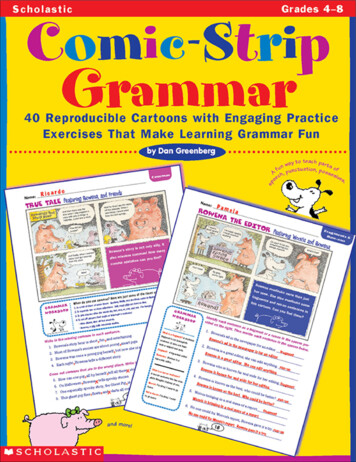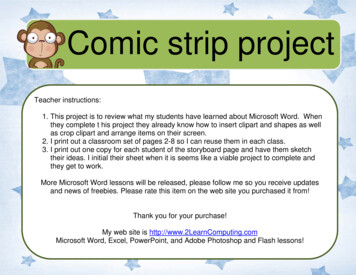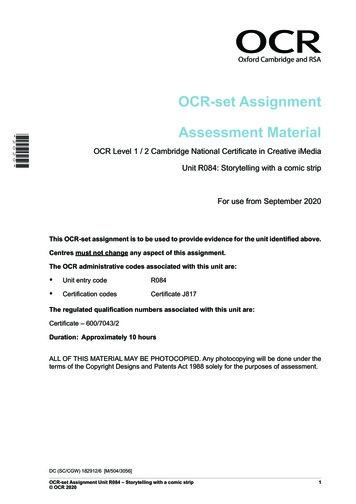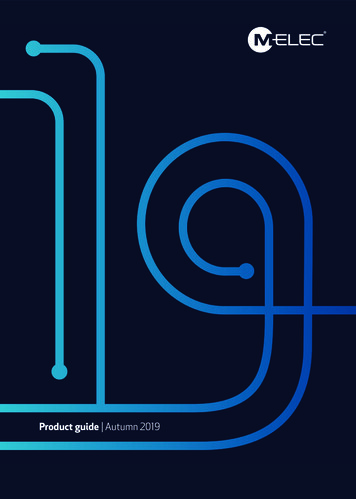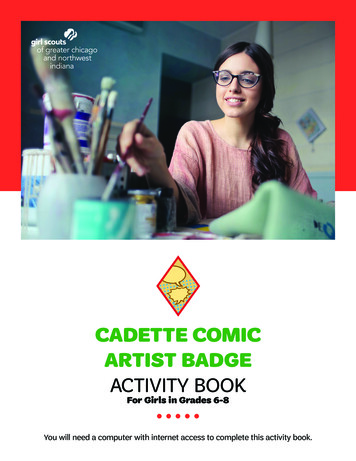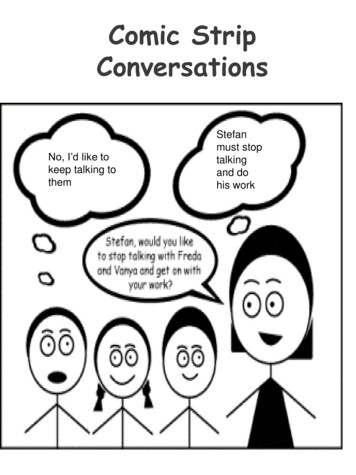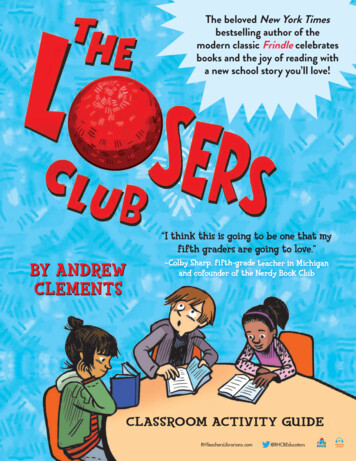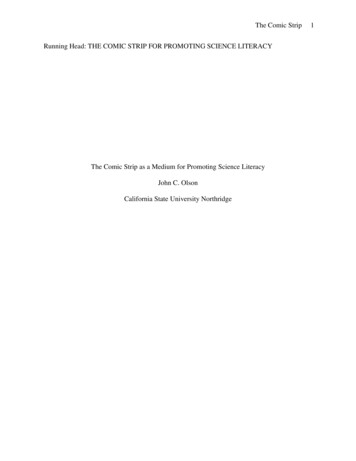
Transcription
The Comic StripRunning Head: THE COMIC STRIP FOR PROMOTING SCIENCE LITERACYThe Comic Strip as a Medium for Promoting Science LiteracyJohn C. OlsonCalifornia State University Northridge1
The Comic Strip2ABSTRACTThe objective of this action research project was to evaluate the use of comic strips in the scienceclassroom as a methodology to promote science literacy by increasing opportunities for studentsto read about, think about and discuss science concepts and science issues. A curriculum ofscience themed comic strip warm ups was developed to provide students an opportunity to read,discuss, and respond to the content of the comic strips. During the course of the study, studentscreated their own comic strips and wrote dialogue for comic strips which incorporated relevantscientific academic vocabulary. These activities created artifacts for analysis. Classroomdiscussions were audio recorded and transcribed. An experimental component compared comicstrip treatments to lecture and note taking methodology. Scores were collected and studentperformance analyzed. Students’ written responses were coded and analyzed. Representativesamples and scores from rubrics indicated students were engaged in meaningful activities thatpromoted students’ scientific literacy. Quiz and test scores provided quantitative evidence of thecomic strip treatment increasing student performance, but only on very specific conceptsintroduced through curriculum lessons. Participants’ survey responses indicated that students’perceived working with the comic strips to be fun and that the comic strips enhanced theirlearning.
The Comic Strip3The Comic Strip as a Medium for Promoting Science LiteracyChapter IIntroductionIn my classroom, warm-ups had traditionally involved the reading of text, taking notesfrom context, and the reproduction of drawings and concepts from the textbook. Other activitiesinvolved creating data charts or filling out portions of lab reports. Upon entering the classroom,students were expected to begin working on a warm-up posted on the front board. These warmups usually involved students working individually at their seats on a task related to the days’lesson. During this time, attendance was taken, individual questions answered and addressed, andthe process of completing daily opening business was completed.Depending on the skills involved; reading, writing, note taking, drawing diagrams,several students each period had trouble getting on task. These students resisted those activitieswhich were challenging, difficult, or that proved tedious for them. What my traditional warm upsfailed to allow for were the different learning style preferences of the students.In addition, the standards-based focus of the curriculum did not allow sufficient time forstudents to read, think, or talk about science and science issues, which raised concern that I wasnot addressing my students’ science literacy beyond the content standards. The comic stripcurriculum used in this study was designed to have students reading silently and aloud, listening,discussing, analyzing and writing. The format was designed to incorporate several of thesemodalities into each activity during the warm up period. This format still allowed time for thepresentation of required content. This was accomplished by transferring important warm up tasksto homework assignments, and revamping the type and quality of homework given. In thismanner, the cartoon strip curriculum could be used in the classroom without a significant impact
The Comic Strip4on structured content lessons. Rather, the cartoon curriculum was intended to support thecurriculum.Promoting science literacy is a challenge facing science educators at all levels (Carrier,2005; Creech & Hale, 2006; Fang, 2006). The demands of preparing students for standardizedtests and covering content standards leave little time for science educators to teach the reading,listening and writing skills unique to their discipline, much less allowing students to have opendiscourse about the meaning of science, and the role of science in their everyday lives. Finding away to capture the interest of a classroom with a wide variety of background experiences andlearning styles was a separate but equally daunting task. However, the cartoon warm upsaddressed in this study were one alternative to address this concern. Hapgood and Palincsar(2007) argued that “finding time for science instruction and literacy instruction does not have tobe an either/or proposition,” (p. 60). They further stressed that combining instruction and literacycan produce a better result. To help students become comfortable talking about scientific ideasand issues, as well as encouraging them to discuss the content presented in their lessons,educators must look for creative opportunities for students to discuss and debate science issueswhile still allowing time in class to cover the required content. Wallace (2004), stressed thatstudents would be better served if they were given the opportunity to apply the language ofscience to their everyday experiences. The challenge is to identify whether talking about scienceas it relates to everyday life has a part in the current trend towards heavily weighted standardizedtesting and content standard instruction.This objective of this study was to evaluate comic strips as a forum for students to think,talk, and write about science in everyday terms, thus supporting their science literacy, whilemaking the content more accessible to the strengths of different learning styles. The genre of the
The Comic Strip5comic strip, with its blend of dialogue and images allows students to gain and interpretinformation in a unique and accessible format. A comic strip opens a window to our societythrough the stories it presents. Research has shown that students learn best when many modes ofinstruction are used. Multimodality is inherent to the comic strip format. Knain, (2006),underscores this notion when he states:Multimodality should be part of the model both as an aspect of the competence of scienceliteracy that students are expected to acquire, but also as a valuable tool for developingscience literacy, by enabling transformations across different modes of representation anddifferent contextual presuppositions, in particular, between everyday and scientificcontextual frames. (p. 659)Although there have been several articles and studies about the use of comic strips in theclassroom to promote literacy (McVicker, 2007; Morrison, Bryan, & Chilcoat, 2002; Weitkamp& Burnet, 2007; Wright & Sherman, 1999), no study specifically addressed an ongoing, dailycomic strip that allowed students to become interested and involved in the “lives” of thecharacters and the ongoing content of the comic strip. It was noted in one study that one of theappealing aspects of narrative texts in science, specifically storybooks, was the inclusion ofhuman and animals as characters. The presence of these types of characters involved studentspersonally and emotionally in the text (Fang, 2006).In this study, students were asked to read and respond to a daily comic strip featuring twolab rats. One of the objectives was to see if the students would develop an affinity for thecharacters, which might aid in keeping keep their interest while practicing science literacy. Toaccommodate different learning modalities, the strip was read aloud by the teacher for clarity,emphasis, and vocabulary. Students were asked to participate by taking on roles and reading the
The Comic Strip6dialogue of the two rat characters. Students discussed the strip in a classroom forum, evaluatingthe background information from the drawings. Only after the students had heard the strip readaloud and understood the setting were they allowed to write down their responses. Later in thestudy, more extensive activities involving comic strips were added to the curriculum.The format of the study incorporated a daily warm up of reading and responding to ascience themed comic strip featuring two lab rats. Students participated in this process byresponding to the language, humor, dialogue, science issues, science content and characteranalysis addressed in each strip.Purpose StatementThe purpose of this study was to evaluate the effectiveness of a science-themed comicstrip to stimulate student interest in science and science issues and to provide a forum forstudents to respond, discuss, debate, and write about the content of the comic strips. Through theactivities and the treatment components of this study the following research questions wereaddressed:1. Does the use of a science themed comic strip promote science literacy by providingstudents a forum to think, talk and write about science and science issues?2. Do comic strips presenting grade level content improve student performance?3. What do students with different learning styles perceive as the benefits of the cartoonstrip curriculum? What are the drawbacks?Importance of the StudyData in the form of student artifacts, test scores and representative samples collectedduring this study will give some insight into the effectiveness of using comic strips to promotescientific literacy. Participants’ responses concerning the benefits and drawbacks of the activities
The Comic Strip7used in the study will aid in identifying students’ perceptions regarding the value the comic stripformat has for their learning.Definition of TermsNewton and Copernicus: A science themed comic strip featuring two lab rats named Newtonand Copernicus. The strip incorporates science concepts and science issues in an ongoingstoryline about the adventures and misadventures of two lab rats.Science Literacy: Science Literacy has many strata of definitions. In this study, scienceliteracy is defined as students thinking, reading and writing about science in a meaningful,productive way. The literature reviewed in this study presented a wide range of commentary onscience literacy. Highlights of those commentaries included “Science learning is metacognition”(Wallace, 2004, p. 902). Perkins-Gough (2007) argued that “You need at least a familiarity andcomfort with science to tackle many of the activities and issues of modern life . . . even thoughyou don’t need to know the details of every scientific conundrum, you need and awareness ofwhat is and isn’t science” (p. 9).Carrier (2005) identified scientifically literate students as those students who were able to“demonstrate basic skills common to all literacy . . . in the language of the text” (p.5). Shefurther defined scientifically literate students as those students who could “ask, find, ordetermine answers, to questions derived from curiosity about everyday experiences.” The abilityto describe natural phenomenon and predict outcomes, as well as the facility to read scientifictexts with understanding, were also descriptors of a scientifically literate student (Carrier, 2005).
The Comic Strip8CHAPTER IIReview of the LiteratureLiteracyFor middle school teachers, there is now an expectation that literacy is the responsibilityof all educators, not just those in the English or language classrooms, and that reading andwriting in content areas is essential to promote literacy (Loranger, 1999; Paterson, 2007). Middleschool principal Terry Quinn stated that “Literacy has to be a shared responsibility throughoutthe entire school” (Paterson, 2007, p. 12). Quinn organized a committee at his school withrepresentatives from all disciplines who planned literacy and reading activities for all contentareas. The issue of literacy education was also addressed by the Nation Middle SchoolAssociation. That association’s official position was stated as follows: “Integrate reading throughthe curriculum, recognize the multidisciplinary nature of reading instruction” (p.12).Paterson (2007) underscored the need for content area teachers to have a broader view ofliteracy. The discipline of science is no exception. Science teachers must teach the language andreading skills required for their students to succeed in science. Creech and Hale (2006) supportedthis idea when they stated that “reading is an essential part of science literacy. . . ” (p. 22). Thisbroader view of literacy acknowledges that media such as cartoons, web pages, graphs, chartsand even “body language” (p. 13) are viable tools for reaching students. These alternativemethods of delivering content are valuable to students, and students should be given theopportunity to work with these types of media. Paterson (2007) noted that “reading involvesthinking, making inferences, and making connections, and we [learners] read many things thatare not traditional text” (p. 13). This demonstrated a need to expand the core meaning of literacy.
The Comic Strip9Teachers in content areas may not be comfortable teaching reading and writing skills.These same teachers will have the additional challenge of working not only with strugglingreaders, but also resistant readers. In her paper on resistant and struggling adolescent readersLenters (2006) warned that “resistant readers risk becoming struggling readers” (p. 136). Lenterswent on to explain that resistant readers felt themselves capable of reading, and that the act ofreading itself was not the cause of their resistance. Rather, these resistant readers noted almostunanimously that “lack of interest in the reading materials they are provided” (p. 137) was at thecore of their resistance to content reading. Students interviewed during Lenters’ research offeredthis advice to content area teachers: “. . . choose interesting stuff. Don’t try to make us readboring stuff,” (138). One textbook evaluation reported by Perkins-Gough (2007) added supportto that disgruntled students admonition, stating that “science textbooks covered many topicssuperficially and were full of disconnected facts” (p.13). They warned that students were likelyto become bored with the lack of any real in-depth materials. If students are resistant, bored, orunmotivated to read, educators must look to other mediums to present content while addressingliteracy.Teachers and administrators will continue to face challenges in content area literacy.Loranger (1999) argued that our changing economy will place a higher emphasis on reading andwriting skills as we transition from manufacturing to technology based careers. To address thisissue, Loranger suggested that “reading in the content area is seen as a viable way to address thatliteracy crisis” (p. 239). Loranger’s paper investigated a pilot program at one school where thefocus question of the study was “how can reading in the content areas be taught effectively in themiddle school?” (p. 239). Teachers in that study identified key areas to help their studentssucceed. These areas included differentiating between narrative and expository text, strategies
The Comic Strip10for using prior-knowledge, helping students with metacognition, (knowing how they learn) andteaching them study strategies.The study data indicated that “an integrated approach to reading can be implemented in amiddle school environment” (Loranger, 1999, p. 243). Recognizing that “the challenge ofcontent area literacy” (p. 239) can be addressed, should offer encouragement to content areateachers who feel they are not capable of teaching reading, writing and literacy skills in theircontent area.Science LiteracyLiteracy within the content area of science is a complicated, multifaceted concept. Thereare many differing viewpoints as to what science literacy actually encompasses. Knain, E. (2006)commented that there has been progress in narrowing down what science literacy actually is. Henoted that “. . . progress has been made in getting a clearer theoretical and empiricalunderstanding of this concept.” He further stated that scientific literacy is no longer something tobe dismissed “as a useful myth” (p. 656). But within the literature there exists a wide range ofopinions concerning the definition of scientific literacy.Many studies (Creech and Hale, 2006; Fang, 2006; Perkins-Gough, 2007; Wallace, 2004)presented sound arguments towards the understanding of what defines science literacy. Wallace(2004) listed “knowledge of scientific vocabulary, understanding the nature of inquiry in science,being able to use scientific concepts in everyday life, and being able to read and interpretscientific information in the popular press” (p. 901) as skills that demonstrated scientific literacy.Further, Wallace defined scientific literacy as skill where “reading and writing in thefundamental sense are essential for science learning . . . [and] . . . developing facility withreading and writing scientific texts is critical to developing scientific literacy in the broad sense”
The Comic Strip11(p. 902). In an interview with Alan Leshner, then CEO of the American Association for theAdvancement of Science, Perkins-Gough (2007) quoted Leshner’s belief that one needs “at leasta familiarity and comfort with science to tackle many of the activities and issues of modern life.Even though you don’t need to know the details of every scientific conundrum, you need andawareness of what is and isn’t science” (p. 9). Creech and Hale (2006) noted: “we are learningthat science literacy is not a fixed object . . .” and that students are “. . . evolving readers” (p.24).These diverse opinions underscore the complex task of defining science literacy.Wallace (2004) presented a theoretical framework, the purpose of which was to create amodel on which to base research on scientific literacy. Wallace states that scientific literacy iscomprised of three related skills. The first of these is that a scientifically literate person can bothread and write scientific texts. This person should also be able to argue scientific concepts at afundamental level. The third skill is that of metacognition, the ability to self monitor learning.The framework Wallace (2004) discusses is composed of three elements. The firstelement is “Authenticity in scientific language use” (p. 903). The idea behind this authenticity ofscientific language is that a student should be able to speak from his or her point of viewcorrectly using the vocabulary and concepts of the science he or she is discussing. Wallace statedthat “when the child needs to use scientific language to express her own experience, she will beauthentically communicating” (p.903). This action research project addresses a forum forstudents to talk about scientific ideas and issues. Without a basic understanding of the style oflanguage students are using to communicate scientific understanding, the effectiveness of theformat would have been diminished.Multiple discourses are the second leg of the framework. The idea behind multiplediscourses is that there are different levels of scientific language that can and should be used in
The Comic Strip12the classroom. Wallace (2004) cited “casual peer group discussion, or ‘bench work’ talk” (p.905)as one type of discourse. Wallace pointed out other types of discourse that would be moreappropriate in other situations, such as a group presentation, a written piece of work, and thereading and use of text from a textbook. The implication of her study is that students need to becomfortable with all of these forms of discourse.Wallace talked about the concept of a “third space” where what is spoken by one personis not precisely what they meant, and that the person who hears what is said will have a slightlydifferent interpretation than the speaker. Wallace indicated that “in the science classroom, theimplication is that neither the teacher’s meaning, nor the student’s meaning for an utterance isthe correct meaning, but that learning will involve the negotiation of meaning until either there isa mutuality of meaning, or a new hybrid meaning is constructed” (p. 908). The implication ofthis third space is that science discourse must be thorough and accurate, and that misconceptionsand preconceptions need to be dealt with in order for the student to achieve a scientific, orliterate level of understanding.Students in middle school science not only having to shift to reading informational text,instead of the more comfortable narrative texts of elementary school, but they also are faced withthe challenge of learning and working with the language of science that is prevalent in the textthey read in school and independently (Fang, 2006). In her study, Fang cited multiple keyelements of scientific language that are different from the everyday language the students areused to reading, speaking and hearing. At this time, when students are expected to transitionfrom learning how to read into the more challenging ‘reading to learn format’, they encounter adramatic change in the type of reading materials they use. These texts are complex, densematerials where common words have different meanings and sentence structure favors a passive
The Comic Strip13voice. The use of the passive voice allows scientific writing to be more objective, but it removesseveral types of contextual clues, resulting in confusion for readers not trained in the readingskills required by scientific writing. Fang studied a wide range of language structures unique toscience including: complex sentences, interruption construction wherein a noun is separated fromits verb by a supportive clause, and the use of densely packed, lengthy nouns. Fang gave thisexample: “A tornado is a rapidly whirling, funnel-shaped cloud that reaches down from a stormcloud to touch earth’s surface” (p. 501) to underscore the idea of a densely packed noun.Fang (2006) described strategies for educators to use to address this complex challenge.Such strategies for reinforcing scientific literacy included vocabulary building, noun expansion,sentence completion, paraphrasing, and sentence stripping. All of these approaches includedmethods to help students decode the complex language of science. In order for students tobecome scientifically literate, their reading must include scientific texts such as classroomtextbooks and trade journals, as well as less traditional media (Creech & Hale, 2006; Zmach, etal., 2007).The authors of another study (Zmach et al., 2007) warned that science teachers needed totake the initiative to get their students reading by giving students access to enjoyable, readablebooks and other texts. The motive behind this was to improve students’ ability to acquirestrategies that would enable them to use their textbooks more effectively. The authors alsoadmonished “researchers outside the classroom to reach out [to content area teachers] withsupport” (p.65). Their contention was that teaching reading was not to be considered an addedchore for content teachers, but an expected process to promote content area literacy.Visual Literacy
The Comic Strip14One of the intrinsic aspects of a comic strip is the blending of text and dialogue withvisual background information. This background information can provide important contextclues to help the reader interpret the text. Understanding the role of visual images supporting textis necessary to understand the value of the mixed medium of a comic strip. In a study whichanalyzed visual images in textbooks and news articles, Dimopoulos, Koulaidis, & Sklaveniti,(2003), disagreed with the premise that it is through the language of a culture that “messages andmeanings primarily reside and that visual illustration is a relatively transparent andunproblematic window to reality.” They further argued that visual images were “autonomoussystems of communication. . . .” which have “. . . specific conventions embedded in theirconstruction. . .” (p. 190). The authors implied that these conventions made images powerfuland systematic communication tools. It could be argued that the same would be true for theimages in a comic strip, that they communicate a great deal of information on their own, andeven more when linked with text.In their research the authors noted that these two formats (textbooks and news articles)are “. . . the most important. . .” formats used to communicate information about technology andscience to “. . . non-specialized publics. . . ” (p. 189). Their study analyzed the visual imageswhich were incorporated into these types of texts. They noted in their findings that the ratio oftext to images in a textbook compared with a magazine or news article was nearly ten timesgreater (Dimopoulos, et al., 2003). School science textbooks analyzed averaged “11.1images/1000 words” (p. 201). Of those images, the authors found that “eighty nine percent” ofthe images were realistic. The authors noted that these numbers were intrinsic to thecommunication of the related text, concluding that the inclusion of images was a powerful wayto help students understand the abstract ideas presented in science classrooms. When addressing
The Comic Strip15the actual function of the visual images tied into the text, the authors suggested that illustrationsare employed to help non-specialists, or lay readers by showing them pictorial models of theappearance and structure of scientific artifacts (Dimopoulos, et al., 2003).Dunsworth and Atkinson (2007) studied the role of an animated agent, a character on acomputer screen which interacts with the learner while they are engaged in computer basedinstruction. While comic strips are static, as opposed to the mobility of a graphic character on acomputer screen, some comparisons are valuable for consideration. Their research suggested thatthe behaviors of the onscreen character mimics modes of non-verbal communication. Theyargued that “agents capable of these behaviors are considered powerful additions to multimedialearning environments” (p.678). Their research inferred that this is done by combining bothverbal and non-verbal communication forms.Dunsworth and Atkinson (2007) continued with the idea that learners are capable of“dual channel information processing” (p.678). This is attributed to the cognitive ability of alearner to get input simultaneously from visual and auditory clues. When presenting the comicstrip curriculum in this study, the dialog was always read aloud by the teacher and then repeatedby students while the class followed along. In this manner, the students were hearing thedialogue of the characters as well as viewing the background context of the cartoon strip beforethey were asked to respond to the strip. The authors noted in their study that “. . . when wordsand images are involved in the instruction, verbal information delivered in an auditory ratherthan a visual mode decreases the cognitive load and increases the size of working memorybecause our cognitive architecture can receive information from both auditory and visualchannels simultaneously” (p. 697). This implied that using comic strips with students might bemore effective if the dialogue was read aloud while students looked at the pictures.
The Comic Strip16One of the interesting findings of the animated agent study was that the use of theonscreen agent yielded a large effect in terms of students’ success in answering retentionquestions (Dunsworth and Atkinson, 2007). The study suggested that this improvement was theanimated agent’s ability to “carry motions such as speech, gazes, gestures or pointing on thescreen” (p. 687). They speculated that by adding the animated agent, the role of the computerchanged from a tool that delivered information to a “social character that bears personal featuresto induce social responses” (p. 687). Although the characters in the comic strip used in this studywere rats, not human characters, and static, not animated, they did mimic the same motionsmentioned above, speech, gazes, gestures, pointing, and because the were given human-likeemotions and intellect, they may have engaged students in the same manner.Visual literacy can be supported by incorporating the visual and communicative arts.Learners take in information visually from the complex society around them (Flood & Lapp,1998; Lin, 2003) and are multi-media consumers of visual information.Flood and Lapp (1998) described a brief case study, summarizing the morning activity ofone child in a San Diego elementary school. They described the media that filled her day as sheread her cereal box, listened to her mother’s directions in Spanish, and admired her favoritebookstore on her way to school. She observed friends playing a video game, read billboards, andconversed in English about an upcoming fieldtrip to the zoo. Upon her arrival at school, sheobserved students practicing a dance routine while anticipating her Internet project. The authorsof the study argued that it is necessary to “broaden our notions of acceptable literacy texts”(p343). They further noted that a large number of educators have “hierarchies of acceptability forthe visual and communicative arts” which were in conflict with the types of media the studentswould encounter in the real world and in the workplace.
The Comic Strip17Flood and Lapp’s (1998) argument stressed that there seemed to be an “irrational loyaltyto reading and writing” (p. 343). The tendency was to resist incorporating other visual arts thatmight impede on the progress of reading and writing. The authors speculated that byperpetuating this resistance to integrate information and forms of display, the schools wouldcontinue to miss out on teaching the knowledge learners need to function in society. Weitkampand Burnet (2007) argued that comic strips were one of the communicative arts that were illfavored and excluded from the acceptable hierarchy. They further stated that comic strips hadmuch to offer in terms of visual literacy and that comics had been unfairly maligned. Lin’s(2003) article on literacy instruction supported the idea that education should be more willing toembrace new and different formats for increa
comic strip, with its blend of dialogue and images allows students to gain and interpret information in a unique and accessible format. A comic strip opens a window to our society through the stories it presents. Research has shown that students learn best when many modes of instruction are used. Multimodality is inherent to the comic strip format.


